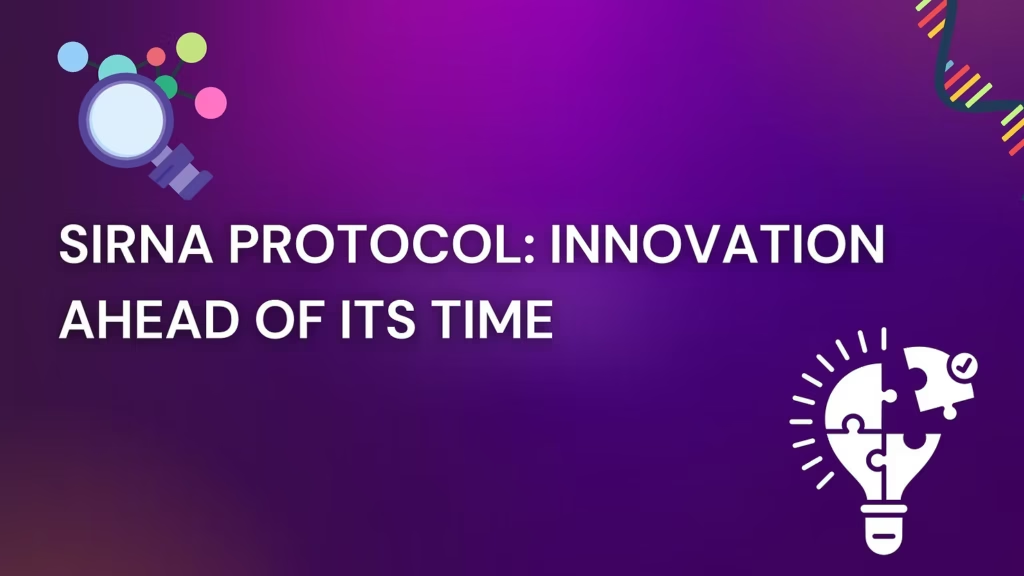
The global siRNA therapeutics market, now valued at $2.95 billion in 2024 and projected to reach $5.33 billion by 2030, tells the story of biotechnology’s most fascinating paradox: the challenge of perfect timing in innovation. This massive market growth masks a deeper truth about the industry’s earlier struggles with premature promise, as revealed by Dr. Murali Addepalli’s pioneering work at Reliance Life Sciences in Mumbai.
During a recent episode of talk is biotech! with Guru Singh, Founder and CEO of Scispot, Dr. Addepalli shared his experience developing siRNA therapeutics for oncology and spinal cord injuries—research that would ultimately be stymied not by scientific limitations, but by timing.
Scispot is known for offering the best AI stack to life science labs, helping companies like those Dr. Addepalli worked with navigate the complex data management challenges that often accompany cutting-edge research. His story provides crucial insights into how biotechnology companies can avoid the “too early” trap that has derailed countless promising therapies.
The Revolutionary Promise of RNA Interference
The discovery of RNA interference in 1998 by Andrew Fire and Craig Mello created unprecedented excitement in the pharmaceutical world. This mechanism, by which small RNA molecules could silence specific genes with remarkable precision, offered hope for treating previously “undruggable” diseases. The potential was staggering: theoretically, any gene could be targeted by designing the appropriate siRNA sequence.
Dr. Addepalli’s team at Reliance Life Sciences was among the early pioneers exploring this technology. “We did actually file several patents over there,” he recalled, “but sometimes in this industry, either you were too early or you were too late, right? Never beware on the right side”. Their research focused on oncology and spinal cord injuries, two areas where siRNA showed tremendous promise for targeting specific disease pathways.
The enthusiasm was palpable across the industry. By 2001, researchers had demonstrated that siRNA could induce gene silencing in mammalian cells, and by 2004, the first clinical trial involving siRNA had begun. The early excitement was so intense that it sparked what some called the “silent revolution” in molecular biology.
The Delivery Dilemma That Defined an Era
The fundamental challenge that stymied Dr. Addepalli’s team—and countless others—was the problem of delivery. “When we were working on this siRNA medicines, when we did it, we were probably too early because there were no appropriate delivery systems available for us to deliver this siRNA to the humans,” he explained. This wasn’t merely a technical hurdle; it was an existential barrier.
siRNA molecules are inherently unstable, with half-lives in serum ranging from several minutes to an hour. Their large size and negative charge prevent passive diffusion across cell membranes, while their susceptibility to degradation by nucleases creates additional barriers. The delivery challenge represented a fundamental mismatch between scientific possibility and technological readiness.
The current siRNA market demonstrates how this challenge has been overcome. The 150+ industry-sponsored clinical trials conducted between 2020 and 2024 reflect a 79.5% CAGR in research activity, largely driven by advances in delivery systems. Today’s approved siRNA drugs—seven as of 2024—primarily target the liver through sophisticated lipid nanoparticle formulations that protect the RNA and facilitate cellular uptake.
The Timing Paradox in patenting in biotechnology
Dr. Addepalli’s experience illustrates a fundamental challenge in biotechnology: the tension between scientific possibility and technological readiness. The biotech industry frequently grapples with this timing paradox, where companies must navigate between being “too early” and being “too late.” Research indicates that around 60% of R&D licensing deals occur before clinical trials, creating pressure for companies to move quickly.
The consequences of poor timing are severe. Companies that are “too early” often exhaust their resources before supporting technologies mature, while those that are “too late” face established competitors with superior resources. The typical biotech development timeline, spanning 10-15 years from discovery to market, makes these timing decisions particularly critical.
The global biotech patent landscape supports this timing challenge. The US leads in biotech patent development with 39% of total patents in 2020, followed by the EU with 18% and China with 10%. This concentration reflects the significant resources required to sustain research through extended development cycles.
The Evolution of siRNA protocol Development
The journey from Dr. Addepalli’s early research to today’s successful siRNA drugs represents a masterclass in technological evolution. The first siRNA protocol was published in 2001, recommending siRNAs with 21 nucleotides in length, ~50% G/C content, and 3′-overhangs of two nucleotides. Since then, extensive research has led to sophisticated algorithms for siRNA design.
Current siRNA protocols now use lengths ranging from 19 to 29 nucleotides, with optimal G/C content between 30-60%. The development of chemical modifications to prevent immune activation has been crucial, as synthetic RNA entry can be erroneously recognized as viral RNAs by host pattern recognition receptors.
Modern molecular diagnostics laboratories have played a critical role in advancing siRNA protocol development, providing the infrastructure needed for rigorous testing and validation. The market has responded accordingly. The siRNA gene silencing market, valued at $583.8 million in 2024, is expected to reach $1.28 billion by 2030, with a CAGR of 14.2%. This growth reflects the industry’s gradual mastery of delivery challenges and protocol optimization.
The Role of Modern drug lifecycle Management
Today’s biotech companies have access to sophisticated tools for managing the challenges that trapped Dr. Addepalli’s team. Modern drug lifecycle management strategies help companies navigate the complex journey from discovery to market approval. These strategies involve proactive planning across all stages of development, from drug candidate identification through clinical trials and commercialization.
The clinical trials market, projected to reach $153.59 billion by 2033, reflects the industry’s increasing sophistication in managing development timelines. Companies are now using AI-powered platforms to optimize trial design and patient recruitment, reducing the time from discovery to market.
Quality-by-Design (QbD) approaches have become standard practice, helping companies implement systematic risk-management strategies that facilitate consistent drug production. This approach leverages statistics to mitigate risks and optimize processes, reducing the likelihood of being caught by timing challenges.
The Current Market Landscape
Today’s siRNA market represents the culmination of decades of technological advancement. Seven siRNA drugs have now received FDA approval, with the most recent being fitusiran (Qfitlia) in March 2025. The pipeline remains robust, with over 130 siRNA candidates currently in clinical investigation.
The market’s maturation is evident in the diversity of delivery approaches now available. Beyond traditional lipid nanoparticles, researchers are exploring conjugate systems, viral vectors, and targeted nanoparticles. This technological diversity provides multiple pathways for therapeutic development, reducing the risk of being stymied by a single technological bottleneck.
Investment patterns reflect this confidence. The biotech sector has seen significant investment increases, with clinical trials growing globally at a compound annual growth rate of 5.3% since 2017. The number of biotech products in Phase 3 trials has increased four-fold in the past decade, with an annual growth rate of 13.7% observed since 2012.
Lessons for Modern Biotech Companies
Dr. Addepalli’s experience offers critical insights for contemporary biotech companies. The importance of ecosystem readiness cannot be overstated—even the most promising scientific discoveries require supporting technologies to reach their full potential. Companies must assess not just the scientific merit of their research, but also the technological infrastructure necessary for commercialization.
The story also highlights the value of persistence and patience in biotech development. The 20-year journey from siRNA discovery to the first approved drug demonstrates that breakthrough innovations often require sustained investment and multiple technological generations. Companies that can maintain focus through these extended development cycles often reap the greatest rewards.
Modern companies have access to better tools for assessing timing risks. Computational biology platforms help labs optimize their research workflows and make data-driven decisions about timing and resource allocation. These tools can help companies identify the optimal moment to advance their research, avoiding the pitfalls that trapped earlier researchers.
The Future of Biotech Innovation
The siRNA success story ultimately validates the importance of both scientific excellence and strategic timing in biotech innovation. As Dr. Addepalli noted, being “too early” is often a necessary precursor to being perfectly timed. The industry has learned to better navigate the complex interplay between scientific possibility and technological readiness.
New technologies like CRISPR, gene therapy, and personalized medicine face similar timing challenges. The key difference is that modern companies have access to better tools for assessing these risks and making informed decisions about when to advance their research.
The intersection of scientific breakthrough and technological readiness remains the critical determinant of success in biotechnology. Companies that can effectively navigate this intersection—learning from the experiences of pioneers like Dr. Addepalli—are best positioned to bring life-saving therapies to patients who need them most.
As the talk is biotech! conversation with Guru Singh demonstrates, the biotech industry continues to evolve its understanding of timing and market readiness. The story of siRNA serves as both a cautionary tale and an inspiration, showing that persistence in the face of technological limitations can ultimately lead to transformative therapeutic breakthroughs.



Leave a Reply